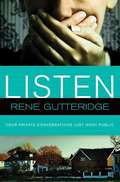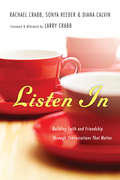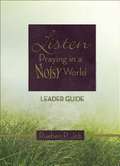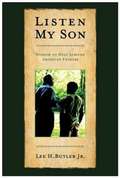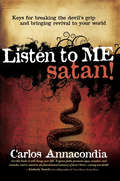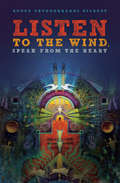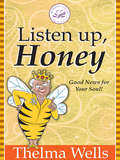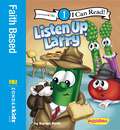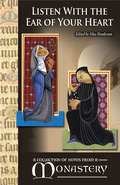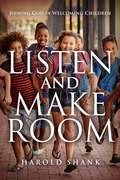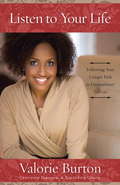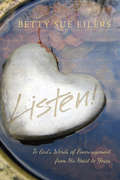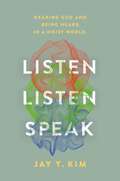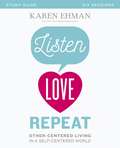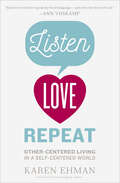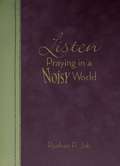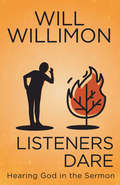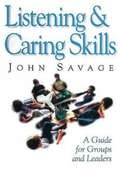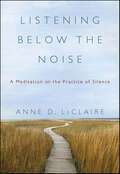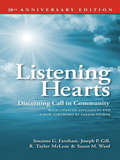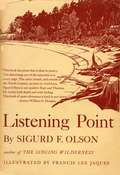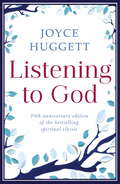- Table View
- List View
Listen
by Rene GutteridgeNothing ever happens in the small town of Marlo . . . until the residents begin seeing their private conversations posted online for everyone to read. Then it's neighbor against neighbor, friend against friend, as paranoia and violence escalate. The police scramble to identify the person responsible for the posts and pull the plug on the Website before it destroys the town. But what responsibility do the people of the town have for the words they say when they think no one is listening? Life and death are in the power of the tongue.
Listen In: Building Faith and Friendship Through Conversations That Matter
by Rachael Crabb Sonya Reeder Diana Calvin2015 Readers' Choice Award Winner
Listen Leader Guide: Praying in a Noisy World (Listen)
by Rueben P. JobWe live in a world of noise. Everywhere we go, we hear sounds that compete for our minds and hearts. Listening to God requires a deliberate choice to shut out the chaos around us and focus our thoughts.Listen, by Rueben P. Job, is a 40-day experience created to offer help to those new to prayer, those with a daily prayer routine, and those whose lives seem too busy to pray. With a focus on listening prayer and prayer as a two-way conversation, the experience will assist individuals and groups in building and deepening a personal prayer practice and spiritual discernment.As we learn to listen, we find a new depth and fulfillment in our relationship with God and a new experience of God as guide and companion in our lives. The daily prayer pattern includes an invitation, silence, Bible reading, a story, guided time for reflecting and listening, and practical help for developing six specific prayer practices.Listen is perfect for use by individuals, small groups, or congregations during Lent, Easter, or any time of year.
Listen My Son: Wisdom to Help African American Fathers
by Lee H. Butler JR.Straight talk about what it means to be African American men. "Let’s have a conversation. Let’s talk man-to-man and brother-to-brother. Let’s talk about how we grow into adults and what manhood means. Let’s talk brother-to-brother and man-to-man about how we relate to one another as we grow into adults. Let’s talk about what defines our maleness and our manhood. Let’s talk brother-to-brother as African American men. Let’s talk openly and honestly about what it means to be black men and American. We can no longer assume that we all know what it means to be African American men. This is a conversation that is long overdue. Let’s talk together and listen to one another. This is our time to talk instead of being talked about. It is time for us to shed the unhealthy images and opinions that we have accepted as the standards of what it means to be Black men. The benefits of our talk will transform our souls as well as benefit all the girls and women in our lives." from the book
Listen To Me Satan!: Keys for breaking the devil's grip and bringing revival to your world
by Carlos AnnacondiaThis is the true story of Carlos Annacondia, whose faithfulness, devotion, and faith in signs and miracles brought about an awakening in Argentina that has spread throughout the world and continues to this day. Annacondia's ministry is marked by the same signs and wonders of the early church—sick bodies are healed, bondages are broken, the demonized are set free, oppression is lifted—and he knows these subjects as very few people do. LIsten to Me, Satan! is full of amazing testimonies that will renew, inspire, and charge your faith. It's the story of how one man confronted the devil, in the authority of the name of Jesus, and experienced extraordinary results. Join him on his journey from the poor villages of Buenos Aires to a global ministry, and find victory and freedom in your own life as well.
Listen To The Wind, Speak From The Heart
by Roger Thunderhands GilbertImagine sitting around a campfire listening to a wise elder speak wisdom so deep that each short tale could be life changing. Listen to the Wind, Speak from the Heart, tells these kind of stories. Roger Thunderhands Gilbert writes from the heart, passing on the wisdom of his Spirit self in plain, understandable, and passionate language. Thunderhands's integration of Native American, Taoist, and many other wisdom traditions blend seamlessly, illuminating everything from Earth changes, Hopi and Mayan prophecies, ancient star ancestors, global political climate and protests, technology, food and water crisis and other issues. Thunderhands's stories are full of light and hope, teaching of love and life, and of the responsibility to the self, the planet, and all people. Combining shamanistic and Eastern knowledge, healing techniques, and practices, this book delivers an important synthesis of insights for today's global culture.Winner 2013 COVR award - Gold
Listen Up, Honey
by Thelma WellsThelma Wells is a mentor and a friend. Catch her on the run at a Women of Faith conference, or spend a year in her mentoring class, and you're going to be nourished by someone who understands real life and a real relationship with God. As a child, she suffered abuse; as an adult, she is the personal manifestation of love and acceptance. Inspired by the bumblebee who works hard to sweeten the lives of others, Thelma is the queen bee. With bite-sized morsels of wit and reality-based wisdom, flavored always with kindness and grace, Listen Up, Honey! brings sweetness to life without sugar-coating it.
Listen Up, Larry: Level 1 (I Can Read! / Big Idea Books / VeggieTales)
by Karen PothA Lesson about ListeningDetectives Bob and Larry are on another case … why isn&’t Junior getting good grades at school? Can Bob and Larry find out the reason? And who will really learn a lesson?This is a Level One I Can Read! book, which means it&’s perfect for children learning to sound out words and sentences. It aligns with guided reading level J and will be of interest to children Pre-K to 3rd grade.
Listen With the Ear of Your Heart: A Collection of Notes from a Monastery
by Silas HendersonAbbey Press’s Notes from a Monastery series of booklets tried to convey Saint Benedict’s rich insights, common sense, reverence for the divine in the most ordinary things of life, and appreciation for the timeless virtues of humility, obedience, and community in a way that would speak to women and men of faith, regardless of their faith tradition. Recognizing that God is present everywhere and in all the circumstances of daily life, this new eBook offers readers inspiration in their search for God, guided by the spirit of Saint Benedict of Nursia.
Listen and Make Room: Joining God in Welcoming Children
by Harold ShankListen for the cries of the vulnerable and welcome the children for whom Jesus made room. When Jesus made room, the vulnerable came for prayer. He treated their ills. He fixed what was broken. Jesus gave sight to the blind, made the lame walk, and welcomed the little children, creating space for those who had been excluded. Then he listened to those who often had no voice. Today, those people are often children. Finding places for those who are left out, especially children, is the work of discipleship. We rarely listen to those who have small voices in our world. Instead, we fill up all the space ourselves, leaving no room for those who have little ability to acquire a spot. But Listen and Make Room shows us that to follow Jesus’s example means to understand that the vulnerable are at the core of God’s mission.
Listen to Your Heart
by Irene BrandLaurel Cooper was too busy planning her only daughter’s wedding to make time for romance. But the fortysomething widow couldn’t ignore the rugged photojournalist who’d appeared on her doorstep to photograph her antebellum home-turned-boarding house. Especially not when they spent so much time together as she gave him tours of other local historic homes. Micah Davidson made himself indispensable, even covering the wedding as a favor for his lovely new landlady. Yet just as Micah was about to propose, a shocking photograph surfaced, turning Laurel’s world upside down. Could their love outlast the long-buried secrets from Laurel’s past?
Listen to Your Life: Following Your Unique Path to Extraordinary Success
by Valorie BurtonA Better Life Is Calling. Are You Ready to Answer? Consider the current state of your life: your work, your relationships, your accomplishments. Are you in the place you'd hoped or expected to be? Is this the best life you could be living? Or is something missing-something you have not yet discovered or articulated that could lead you to the rich, fulfilling life you desire? Fulfill Your Purpose. Decrease Your Stress. Expand Your Life.
Listen!
by Betty Sue EilersWill the voices clamor around you,Drowning out the whisper of Mine?Will you hearken to My voice,To listen all the time?Do you feel overwhelmed by the cares of everyday life? Author, mother and grandmother Betty Sue Eilers has learned to listen to the voice of God, and to lay down the burdens she was not meant to carry. The heavenly Father has an endless supply of comfort and encouragement to refresh His children during times of uncertainty, if we will spend time in His presence and listen to His voice. Don&’t let the burdens of life get you down. God will fulfill every promise. This collection of poems straight from the Father&’s heart will inspire you to spend time with God each day. Be free to cast your cares upon Him, rest in His presence, and Listen!
Listen, Listen, Speak: Hearing God and Being Heard in a Noisy World
by Jay Y. KimAward-winning author and pastor of WestGate Church gives thoughtful, Biblical guidance for how to hear God and share His love in a culture of noise. The effects of social media and the news are felt deeply in our day-to-day lives. The countless voices—the pundits, the influencers, the personalities—offering opinions and spewing vitriol nonstop have created a cacophony of chaos. It&’s difficult to know what&’s true or who to trust. It&’s difficult to hear God and be heard. In this book, pastor and author Jay Kim offers thoughtful, concrete guidance for how to listen amidst the noise, hear God, and then speak Good News so to be heard. Drawing on Scripture, social science, and cultural exegesis, Kim helps readers: Listen through prayer, reading the Bible, and participating in the church Better understand the environment and effects of social media, news media, and politics Share the Good News in this environment, encouraging those in your day-to-day life Practical, biblical, and eminently wise, Listen, Listen, Speak is an indispensable guidebook for Christians living in our culture today. It will equip you to not just speak into the chaos with the love of Jesus but, more importantly, to listen—to one another and to God.
Listen, Love, Repeat Study Guide: Other-Centered Living in a Self-Centered World
by Karen EhmanIn this six-session video Bible study (DVD/digital video sold separately), Karen Ehman, New York Times bestselling author of Keep it Shut, helps you rediscover the life-changing joy that comes from putting others first. In a culture that tells us a me-first, you-second way of living is the key to happiness, Ehman explains that the key to moving forward in almost every facet of your life is to embrace backward living.Becoming a person who thinks about others first takes effort. It requires you to live alert. To be on the lookout in conversations for “heart drops”—hints of kindness you might grant to the person right in front of you, right where they are.But it is worth it.Listen, Love, Repeat gives you both the encouragement and practical, daily ways you can reach out to others with both planned and random acts of kindness. Topics include loving your family and friends, encouraging coworkers, reaching out to the lonely, blessing the “necessary people” who help you get life done every day but often go unnoticed, and many others who could use an act of thoughtfulness. An additional focus on modeling for your children a lifestyle that listens and loves is accompanied by doable ideas for you and for your family.The Listen, Love, Repeat Study Guide includes video notes, group discussion questions, individual activities, Scripture memory verses, and between-sessions personal studies.Sessions include:Finding Your Big "Why?"Let Love Complete the CircleWhen You Live a Life of WelcomeHow to Hug a Porcupine and Squeeze a SkunkFamily MattersThe Boomerang of BlessingDesigned for use with Listen, Love, Repeat Video Study 9780310082668 (sold separately).
Listen, Love, Repeat: Other-Centered Living in a Self-Centered World
by Karen EhmanOur culture is self-obsessed – in our schedules, relationships, and especially online. (Can you say selfie?) But in this near-narcissism, people are less content than in decades past. Why? Because we forgot the joy that comes from putting others first. Doing so requires us to live alert, listening for &“heart drops,&” hints from those in our lives who need a helping hand or a generous dose of encouragement. Living alert lifts our own spirits, showing us that blessing others blesses us even more.Listen, Love, Repeat offers biblical teaching and suggests doable actions that are simple, heart-tugging, sentimental, even sneaky and hilarious. This message:• Presents scriptural examples of those who lived alert, including Jesus, who noticed those who least expected to be seen.• Explains the role of good works for followers of Christ. They aren&’t our ticket to heaven but they are our marching orders on earth.• Gives creative ideas for showing love to friends and family, and suggests practical ways to reach out to the lonely, the marginalized, the outcast, and the odd duck. Additionally, it helps you comfort the grieving, showing what you can do when you don&’t know what to say.• Provides inspiration for blessing the &“necessary people&” in your life, those often-overlooked souls who help you get life done every day, and teaches you how to hug a porcupine by genuinely loving the hard-to-love.As we scatter love, we create a safe space where we can openly share the gospel. We get to see lives changed right before our eyes. Most importantly, Listen, Love, Repeat will enable you to live a life that is full of kind deeds, not to selfishly shout, &“Hey! Look at me!&” but to humbly implore, &“Will you look at Him?&”
Listen, Vienna: The Life of St. Clement Mary Hofbauer
by James J. GalvinIn many ways this book gives an old history of Germany, France,and Russia during the 18th century. It is a story of deep commitment, lasting faith, and the resilience of the spirit in times of great oppression.
Listen: Praying in a Noisy World (Listen)
by Rueben P. JobWe live in a world of noise. Everywhere we go, we hear sounds that compete for our minds and hearts. Listening to God requires a deliberate choice to shut out the chaos around us and focus our thoughts.Listen, by Rueben P. Job, is a 40-day experience created to offer help to those new to prayer, those with a daily prayer routine, and those whose lives seem too busy to pray. With a focus on listening prayer and prayer as a two-way conversation, the experience will assist individuals and groups in building and deepening a personal prayer practice and spiritual discernment.As we learn to listen, we find a new depth and fulfillment in our relationship with God and a new experience of God as guide and companion in our lives. The daily prayer pattern includes an invitation, silence, Bible reading, a story, guided time for reflecting and listening, and practical help for developing six specific prayer practices.Listen is perfect for use by individuals, small groups, or congregations during Lent, Easter, or any time of year.
Listeners Dare: Hearing God in the Sermon
by William H. WillimonDiscipleship and witness are not self-sustainable. Preaching equips God’s people for the work of serving and building up the body of Christ (Eph. 4:11).The gospel is news that passes from the lips of one who has heard to the ears of one who has not yet heard, then (God willing) it burrows in the soul, energizing the hands in daring response to a word received. Preaching is instigated by an astounding claim: Good news; God has spoken to us. The Christian life is what you get when ordinary folk respond: I have heard.The book (a companion to Preachers Dare) is for anyone who listens to sermons—which includes preachers, since there’s no way to preach without gaining skills as a listener. Listening is a human skill, but as God’s word is proclaimed, the hearer experiences a vocal mix of preacher, listener, and God.Praise for Listeners Dare “Books about preaching—how to research, write, and deliver sermons—are legion. But books about how sermons are heard, internalized, and acted upon by ordinary Christians in the pews are rare. Willimon addresses this elusive yet critically important task with his usual wit, acumen, and pastor’s heart. A few hours pondering this thought-filled work will pay handsome dividends come Sunday.” —Grant Wacker, Gilbert T. Rowe Distinguished Professor of Christian History, Duke Divinity School, Durham, NC“There is no shortage of resources out there for how to prepare and preach a sermon, and yet faith comes from hearing. In turning our attention to the homiletical process of listening, Willimon has given clergy and laity alike a true gift. Together, we get to listen for God’s daring Word—a word that in our hearing brings about holy obedience, persistent hope, and daring discipleship.” —Karoline M. Lewis, Marbury E. Anderson Chair of Biblical Preaching, Professor of Biblical Preaching, Luther Seminary; Program Director, Festival of Homiletics“Listening to a sermon is a spiritual discipline—that is the simple, profound insight that underpins this rich offering from Will Willimon.” —Lauren F. Winner, Associate Professor, Duke Divinity School, Durham, NC
Listening & Caring Skills: A Guide for Groups and Leaders
by John SavageThe secret to leadership and transformation of a group--or of another person--is the quality of the relationship one person has with another. The effective group leader or counselor will be the person who learns how to listen to other people. By studying and employing listening skills, church leaders will engage others more compassionately, allowing them to feel that their needs are being met. These skills can be used with persons who are terminally ill, inactive at church, going through a divorce, in a family with a severely ill person, unemployed, seeking a new church, grieving, traumatized by catastrophe, going through teenage adolescence, in marriage counseling, or leading a ministry team. John Savage offers eleven specific and teachable listening skills for improving relationships among those who do ministry in small-group settings or when offering counsel to others. The skills are taught through oral exercises and unfailingly helpful examples from actual congregational situations. The skills include paraphrasing, productive questions, perception check, expression of feelings and emotions, fogging, negative inquiry, behavior description, and story listening.
Listening Below the Noise: The Transformative Power of Silence
by Anne D. LeClaire“Listening Below the Noise offers readers the possibility of finding grace and peace in the natural world and in ourselves. Elegant and honest… one of those rare books that finds its way into our hearts, and stays there.” — Ann Hood, author of The Knitting CircleA meditation on silence, the art of being present, and simple spirituality from critically acclaimed novelist Anne D. LeClaire (Entering Normal, The Lavender Hour), Listening Below the Noise offers a practical path to achieving calm, peaceful solitude in hectic lives. Practitioners of yoga and meditation of various traditions have long known the curative powers of stillness; in Listening Below the Noise, LeClaire offers her own unique, compelling version of this ancient wisdom tradition.
Listening Hearts: Discerning Call in Community
by Joseph P Gill R. Taylor Mclean Susan M Ward Suzanne G Farnham20th Anniversary Edition: A unique approach to the spiritual practice of discernment for a new generation, with reflections and exercises. Listening Hearts features simple reflections and exercises drawn from scripture and from Quaker and Ignatian traditions, to make the spiritual practice of discernment accessible to everyone, not just clergy or advanced scholars. This seminal work in the Listening Hearts series has been a beloved resource for tens of thousands of individual readers, retreat participants, small groups, and church leaders, as they listen for and respond to God’s call in their lives.
Listening Point
by Sigurd F OlsonListening Point is about the spiritual human connection to the environment. "Each time I have gone there I have found something new which has opened up great realms of thought and interest", Sigurd F. Olson writes. "For me it has been a point of discovery and, like all such places of departure, has assumed meaning far beyond the ordinary". Considered by some to contain Olson's most vivid and moving passages, Listening Point is the nature lover's companion for hearing the depth and beauty of the great outdoors.
Listening To God
by Joyce HuggettWhen we seek God's voice, God is far from silent.In this profound spiritual testimony, Joyce Huggett draws on many years' experience of prayerfully listening to God to offer practical guidance and advice for anyone seeking a new dimension of prayer.Offering encouragement to start out on the journey, she tackles common difficulties honestly, and points towards a thrilling new relationship with God.This book, described as 'a spiritual classic' has over thirty years provided invaluable help to many thousands of people seeking greater depth in their spiritual life. This edition contains a chapter looking at what we can learn from the different streams of Christian spirituality.
Listening To God
by Joyce HuggettWhen we seek God's voice, God is far from silent.In this profound spiritual testimony, Joyce Huggett draws on many years' experience of prayerfully listening to God to offer practical guidance and advice for anyone seeking a new dimension of prayer.Offering encouragement to start out on the journey, she tackles common difficulties honestly, and points towards a thrilling new relationship with God.This book, described as 'a spiritual classic' has over thirty years provided invaluable help to many thousands of people seeking greater depth in their spiritual life. This edition contains a chapter looking at what we can learn from the different streams of Christian spirituality.
